On December 14, 1872, at 9:40 p.m. an earthquake is felt throughout Washington Territory, especially in Western Washington. There are four shocks over an eight-minute period. In Seattle "frame buildings swayed to and fro like a small craft at sea."
A Seattle newspaper reported that the earthquake came in “an undulating motion, from South to North, like waves of the ocean, unaccompanied by any violent jar, or irregular upheaval ...”(Puget Sound Dispatch December 19, 1872). Another paper stated, “frame buildings swayed to and fro like a small craft at sea” (Weekly Intelligencer December 16, 1872).
In Seattle, buildings and trees shook, articles and goods fell off shelves, and clocks stopped running. Water and milk containers sloshed their contents onto the floor, pendulum clocks that had not been running started up, and dishes were broken.
In 1904 a Seattle resident who had witnessed the 1872 earthquake wrote to the Seattle Post Intelligencer the following:
"In the fall of 1872 the hardest shock that has been experienced since the settlement of Seattle occurred. It was a clear moonlight night and very still. The shock came about 10 o'clock. The movement was upward, as of an upheaval, followed by waves from north to south of such severity that it was like walking on the deck of a ship in a wind, and it caused nausea and dizziness. A lady who has lived here ever since said 'I was ill and was sitting in a rocking chair at the time of the great earthquake, and it swayed my chair back and forth and when I tried to walk the floor it seemed to rise in waves.' The plaster was cracked in many houses, dishes were broken, lamps tipped over and articles hanging against the wall rattled sharply. Lake Union was like a sheet of glass just before the disturbance. Just as it was over, large rollers, approaching a tidal wave, came in a number of feet above high water mark. There was also a disturbance of a like character on the waters of the [Elliott] bay. The tall fir trees that stood thick around Lake Union ... swayed back and forth as if a heavy wind were blowing. Indians living on the lake [Union] shore ... were terribly alarmed and rushed from their houses, screaming in excitement. The next day an old Indian named Tesecguia came to the house, saying [in Chinook Jargon]: 'Dabath achieth-tejima culalum Boston hiue mesahche tilacum saukhale tyee hyas solex ticky memaloose nika nika slek lum tum' meaning 'We Indians are bad; also [bad are] the white people. The Great Spirit is angry, he wants to kill me, my heart is heavy'" (Seattle Post-Intelligencer, 1904).
The quake was centered at 48 degrees 48’ 00” North Latitude and 121 degrees 24’ 00” West Longitude (on the eastern slopes of Mount Rainier) and was estimated to be a 7.3 Magnitude earthquake, the largest since 1850. It was felt over a 625,000 square mile area including the Territory of Washington, Oregon, as far south as Eugene City, and north into British Columbia, an area 85 percent larger area then the April 13, 1949, earthquake.
On the Columbia River, just north of the mouth of the Chelan, a bluff collapsed into the river, damming it completely. The next morning, residents downstream were shocked to find the great river empty. This did not last long. When the dam collapsed, a 15-foot wall of water swept to the south.
Catholic missionaries in the area used the event to convert doubtful Native Americans.
On December 17, 1872, an aftershock occurred.

